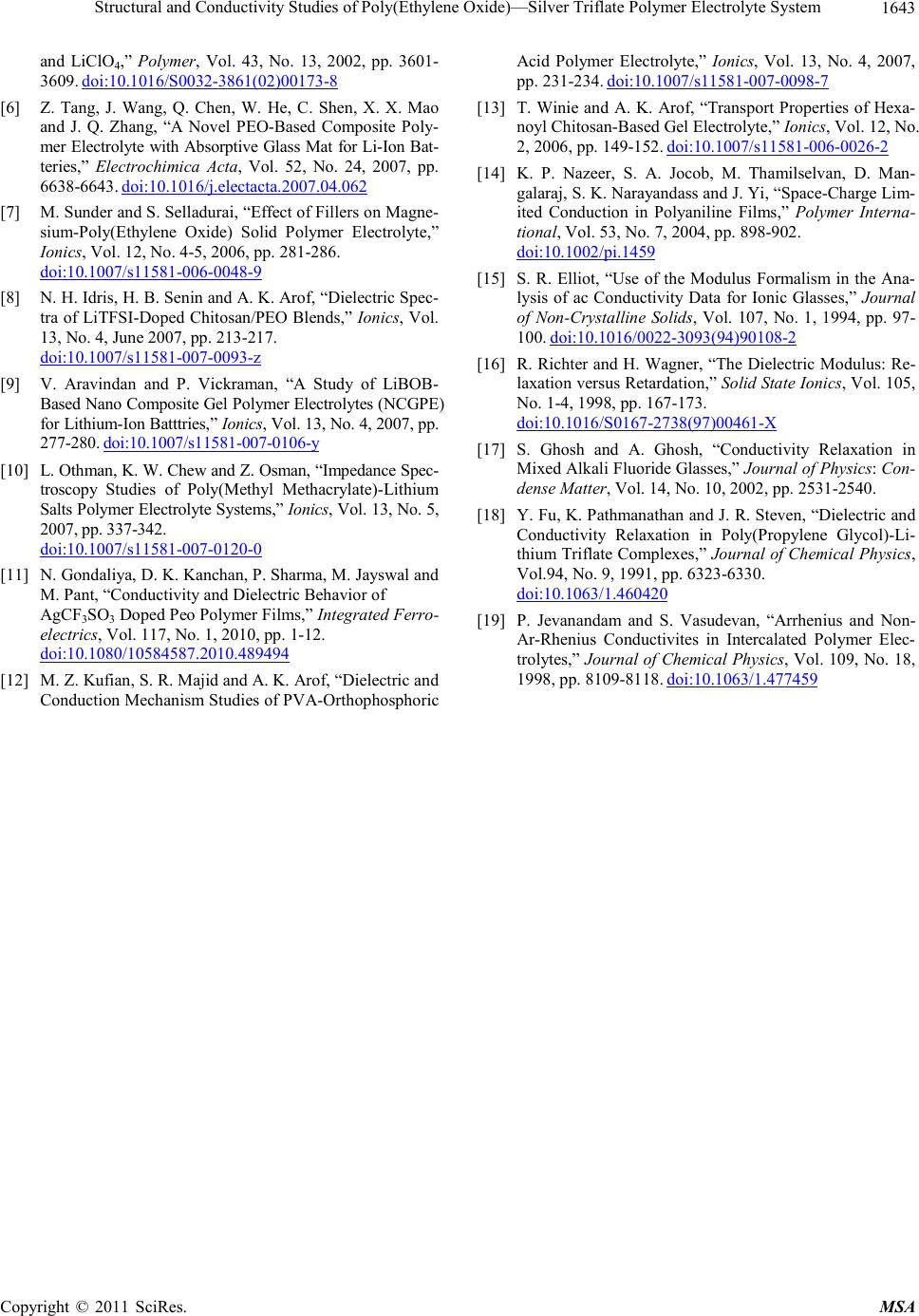
Structural and Conductivity Studies of Poly(Ethylene Oxide)—Silver Triflate Polymer Electrolyte System
Copyright © 2011 SciRes. MSA
1643
and LiClO4,” Polymer, Vol. 43, No. 13, 2002, pp. 3601-
3609. doi:10.1016/S0032-3861(02)00173-8
[6] Z. Tang, J. Wang, Q. Chen, W. He, C. Shen, X. X. Mao
and J. Q. Zhang, “A Novel PEO-Based Composite Poly-
mer Electrolyte with Absorptive Glass Mat for Li-Ion Bat-
teries,” Electrochimica Acta, Vol. 52, No. 24, 2007, pp.
6638-6643. doi:10.1016/j.electacta.2007.04.062
[7] M. Sunder and S. Selladurai, “Effect of Fillers on Magne-
sium-Poly(Ethylene Oxide) Solid Polymer Electrolyte,”
Ionics, Vol. 12, No. 4-5, 2006, pp. 281-286.
do i:10. 1007/s11581-0 06-0048-9
[8] N. H. Idris, H. B. Senin and A. K. Arof, “Dielectric Spec-
tra of LiTFSI-Doped Chitosan/PEO Blends,” Ionics, Vol.
13, No. 4, June 2007, pp. 213-217.
do i:10. 1007/s11581-0 07-0093-z
[9] V. Aravindan and P. Vickraman, “A Study of LiBOB-
Based Nano Composite Gel Polymer Electrolytes (NCGPE)
for Lithium-Ion Batttries,” Ionics, Vol. 13, No. 4, 2007, pp.
277-280. doi:10.1007/s11581-007-0106-y
[10] L. Othman, K. W. Chew and Z. Osman, “Impedance Spec-
troscopy Studies of Poly(Methyl Methacrylate)-Lithium
Salts Polymer Electrolyte Systems,” Ionics, Vol. 13, No. 5,
2007, pp. 337-342.
do i:10. 1007/s11581-0 07-0120-0
[11] N. Gondaliya, D. K. Kanchan, P. Sharma, M. Jayswal and
M. Pant, “Conductivity and Dielectric Behavior of
AgCF3SO3 Doped Peo Polymer Films,” Integrated Ferro-
electrics, Vol. 117, No. 1, 2010, pp. 1-12.
do i:10. 1080/10584587.2010.489494
[12] M. Z. Kufian, S. R. Majid and A. K. Arof, “Dielectric and
Conduction Mechanism Studies of PVA-Orthophosphoric
Acid Polymer Electrolyte,” Ionics, Vol. 13, No. 4, 2007,
pp. 231-234. doi:10.1007/s11581-007-0098-7
[13] T. Winie and A. K. Arof, “Transport Properties of Hexa-
noyl Chitosan-Based Gel Electrolyte,” Ionics, Vol. 12, No.
2, 2006, pp. 149-152. doi:10.1007/s11581-006-0026-2
[14] K. P. Nazeer, S. A. Jocob, M. Thamilselvan, D. Man-
galaraj, S. K. Narayandass and J. Yi, “Space-Charge Lim-
ited Conduction in Polyaniline Films,” Polymer Interna-
tional, Vol. 53, No. 7, 2004, pp. 898-902.
do i:10.1002/p i.1459
[15] S. R. Elliot, “Use of the Modulus Formalism in the Ana-
lysis of ac Conductivity Data for Ionic Glasses,” Journal
of Non-Crystalline Solids, Vol. 107, No. 1, 1994, pp. 97-
100. doi:10.1016/0022-3093(94)90108-2
[16] R. Richter and H. Wagner, “The Dielectric Modulus: Re-
laxation versus Retardation,” Solid State Ionics, Vol. 105,
No. 1-4, 1998, pp. 167-173.
doi:10.1016/S0167-2738(97)00461-X
[17] S. Ghosh and A. Ghosh, “Conductivity Relaxation in
Mixed Alkali Fluoride Glasses,” Journal of Physics: Con-
dense Matter, Vol. 14, No. 10, 2002, pp. 2531-2540.
[18] Y. Fu, K. Pathmanathan and J. R. Steven, “Dielectric and
Conductivity Relaxation in Poly(Propylene Glycol)-Li-
thium Triflate Complexes,” Journal of Chemical Physics,
Vol.94, No. 9, 1991, pp. 6323-6330.
do i:10. 1063/1.460420
[19] P. Jevanandam and S. Vasudevan, “Arrhenius and Non-
Ar-Rhenius Conductivites in Intercalated Polymer Elec-
trolytes,” Journal of Chemical Physics, Vol. 109, No. 18,
1998, pp. 8109-8118. doi:10.1063/1.477459